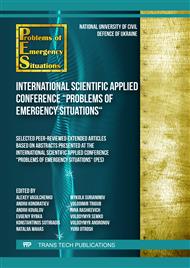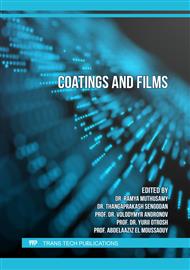[1]
G.I. Gurina, I.S. Zaitseva, B.A. Bogomol, Y.I. Druzhynin, Innovative environmentally friendly solution paint materials, Modern directions of scientific research development, BoScience Publisher. Chicago, USA, (2022) 76–78.
Google Scholar
[2]
B. Pellegrene, M.D. Soucek, Effect of humidity on curing of alkoxysilane-functionalized alkyd coatings, Journal of Coatings Technology and Research, 18(6) (2021) 1543–1555.
DOI: 10.1007/s11998-021-00494-w
Google Scholar
[3]
S. Zhong, K. Qin, Y. Hou, T. Xu, Y. Cai, L. Yi, Waterborne corrosion-resistant hydrophobic alkyd resin composite coatings modified with fluorinated acrylate-siloxane and submicron-sheet zinc phosphate pigment, Journal of Coatings Technology and Research, 18(5) (2021) 1309-1320.
DOI: 10.1007/s11998-021-00493-x
Google Scholar
[4]
H. Fathi Fathabadi, M. Javidi, Self-healing and corrosion performance of polyurethane coating containing polyurethane microcapsules, Journal of Coatings Technology and Research, 18(5) (2021) 1365–1378.
DOI: 10.1007/s11998-021-00501-0
Google Scholar
[5]
L.P Skoryk, O.P. Oliynyk, V.A. Volkov, A novel approach for new cost-saving durable anticorrosive and antibacterial coatings Urban public spaces from the standpoint of sustainable development, TechHub Journal, 2(1) (2022) 49–54.
Google Scholar
[6]
G.I. Gurina, K.V Savchenko, Intercalation and formation of complexes in the system of lead (II) iodide–ammonia, Journal of Solid State Chemistry, 177(3) (2004) 909–915.
DOI: 10.1016/j.jssc.2003.09.028
Google Scholar
[7]
E.A. Tkachenko, Z.G. Bryazkun, G.D. Neskorodzhena, V.Yu. Kramarenko, Computational approaches to determining the VOC content in paints and varnishes, Proceedings of the III International Conference "Young coatings and composites", (2017) 23–27.
Google Scholar
[8]
N. Saienko, R. Bikov, A. Skripinets, D. Demidov, Research of the Influence of Silicate Fillers on Water Absorption and Microstructure of Styrene-Acrylic Dispersion Coatings, In Materials Science Forum, 1038 (2021) 61–67, Trans Tech Publications Ltd.
DOI: 10.4028/www.scientific.net/msf.1038.61
Google Scholar
[9]
G. Gurina, P. Kozub, S. Kozub, N. Saienko, A. Skripinets, Detonation Nanodiamonds as Part of Smart Composite Paintwork Materials, In Smart Technologies in Urban Engineering: Proceedings of STUE-2022, (2022) 393–402.
DOI: 10.1007/978-3-031-20141-7_36
Google Scholar
[10]
M. Hubmann, J.M. Curtis, Monitoring drying process of varnish by immersion solid matching method, Progress in organic coatings, (2017) 136.
Google Scholar
[11]
M. Hubmann, J.M. Curtis, A biobased reactive accelerant and diluent for solvent-free drying oils, Progress in organic coatings, (2019) 157.
DOI: 10.1016/j.porgcoat.2020.106024
Google Scholar
[12]
A. Hofland, Alkyd resins: From down and out to alive and kicking, Progress in Organic Coatings, 73(4) (2012) 274–282.
DOI: 10.1016/j.porgcoat.2011.01.014
Google Scholar
[13]
J. Morin, A. Gandolfo, B. Temime-Roussel, R. Strekowski, G. Brochard, V. Bergé, H. Wortham, Application of a mineral binder to reduce VOC emissions from indoor photocatalytic paints, Building and Environment, 156 (2019) 225–232.
DOI: 10.1016/j.buildenv.2019.04.031
Google Scholar
[14]
N. Suzuki, H. Nakaoka, M. Hanazato, Y. Nakayama, K. Takaya, C. Mori, Emission rates of substances from low-volatile-organic-compound paints, International Journal of Environmental Science and Technology, 16(8) (2019) 4543–4550.
DOI: 10.1007/s13762-018-2093-0
Google Scholar
[15]
A.I. Simion, I. Ionita, C.G. Grigoras, L.G. Favier-Teodorescu, L. Gavrila, Development and optimization of water based paint formula in order to reduce vocs emissions, Environmental Engineering & Management Journal (EEMJ), 14(2) (2015) 277–288.
DOI: 10.30638/eemj.2015.027
Google Scholar
[16]
C.W.F. Yu, D.R. Crump, Methods for measuring VOC emission from interior paints, Surface coatings international, 83(11) (2000) 548–556.
DOI: 10.1007/bf02692699
Google Scholar



